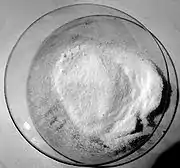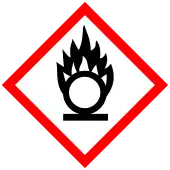 | |||
| |||
 | |||
| Names | |||
|---|---|---|---|
| IUPAC name
Potassium bromate | |||
| Other names
Potassium bromate(V) Bromic acid, potassium salt | |||
| Identifiers | |||
3D model (JSmol) |
|||
| ChEBI | |||
| ChEMBL | |||
| ChemSpider | |||
| ECHA InfoCard | 100.028.936 | ||
| EC Number |
| ||
| 15380 | |||
| KEGG | |||
PubChem CID |
|||
| RTECS number |
| ||
| UNII | |||
| UN number | 1484 | ||
CompTox Dashboard (EPA) |
|||
| |||
| |||
| Properties | |||
| KBrO 3 | |||
| Molar mass | 167.00 g/mol | ||
| Appearance | white crystalline powder | ||
| Density | 3.27 g/cm³ | ||
| Melting point | 350 °C (662 °F; 623 K) | ||
| Boiling point | 370 °C (698 °F; 643 K) (decomposes) | ||
| 3.1 g/100 mL (0 °C) 6.91 g/100 mL (20 °C) 13.3 g/100 mL (40 °C) 49.7 g/100 mL (100 °C) | |||
| Solubility | Insoluble in acetone | ||
| −52.6·10−6 cm³/mol | |||
| Structure | |||
| hexagonal | |||
| Thermochemistry | |||
Std enthalpy of formation (ΔfH⦵298) |
−342.5 kJ/mol | ||
| Hazards | |||
| GHS labelling: | |||
   | |||
| Danger | |||
| H271, H301, H350 | |||
| P201, P202, P210, P220, P221, P264, P270, P280, P281, P283, P301+P310, P306+P360, P308+P313, P321, P330, P370+P378, P371+P380+P375, P405, P501 | |||
| NFPA 704 (fire diamond) | |||
| Flash point | Non-flammable | ||
| Lethal dose or concentration (LD, LC): | |||
LD50 (median dose) |
157 mg/kg (oral, rat)[1] | ||
| Safety data sheet (SDS) | "ICSC 1115". | ||
| Related compounds | |||
Other anions |
Potassium chlorate Potassium iodate | ||
Other cations |
Sodium bromate Calcium bromate | ||
Except where otherwise noted, data are given for materials in their standard state (at 25 °C [77 °F], 100 kPa).
Infobox references | |||
Potassium bromate (KBrO
3) is a bromate of potassium and takes the form of white crystals or powder. It is a strong oxidizing agent.
Preparation
Potassium bromate is produced when bromine is passed through a hot solution of potassium hydroxide. This first forms unstable potassium hypobromite, which quickly disproportionates into bromide and bromate:[2]
- 3 BrO−
2 Br−
+ BrO−
3
Electrolysis of potassium bromide solutions will also give bromate. Both processes are analogous to those used in the production of chlorates.
Potassium bromate is readily separated from the potassium bromide present in both methods owing to its much lower solubility; when a solution containing potassium bromate and bromide is cooled to 0°C, nearly all bromate will precipitate, while nearly all of the bromide will stay in solution.[2]
Uses in baking
Potassium bromate is typically used in the United States as a flour improver (E number E924). It acts to strengthen the dough and to allow higher rising. It is an oxidizing agent, and under the right conditions, will be completely reduced to bromide in the baking process.[3][4] However, if too much is added, or if the bread is not baked long enough or not at a high enough temperature, then a residual amount will remain, which may be harmful if consumed.[4]
Potassium bromate might also be used in the production of malt barley, but under certain safety conditions prescribed by the U.S. Food and Drug Administration (FDA), including labeling standards for the finished malt barley product.[5] It is a very powerful oxidizer (electrode potential = 1.5 volts, similar to potassium permanganate).
Regulation
In October 2023, California passed a law that banned the manufacture, sale, and distribution of potassium bromate (along with three other additives: brominated vegetable oil, propylparaben, and Red 3). This is the first law in the U.S. to ban it, and will possibly have nationwide effects.[6]
Potassium bromate has been banned from food products in the European Union, Argentina, Brazil,[7] Canada, Nigeria, South Korea, and Peru. It was banned in Sri Lanka in 2001,[8] China in 2005,[9] and India in 2016,[10] but it is allowed in most of the United States. As of May 2023, the U.S. state of New York is considering banning the use of potassium bromate.[11] California plans to ban the use of potassium bromate in food starting in 2027, following a bill signed into law in October 2023.[12][13]
Potassium bromate is classified as a category 2B carcinogen by the IARC.[14] The FDA allowed the use of bromate before the Delaney clause of the Food, Drug, and Cosmetic Act – which bans potentially carcinogenic substances – went into effect in 1958. However, since 1991, the FDA has urged bakers to voluntarily stop using it but has not mandated a ban and some bakers still use it. In California, a warning label is required when bromated flour is used.[15] Japanese baked goods manufacturers stopped using potassium bromate voluntarily in 1980; however, Yamazaki Baking resumed its use in 2005, claiming it had new production methods to reduce the amount of the chemical which remained in the final product.[16]
References
- ↑ "Potassium bromate". chem.sis.nlm.nih.gov. ChemIDplus. U.S. National Institutes of Health. RN 7758-01-2.
- 1 2 Synthesis, separation, and purification of KBr and KBrO (PDF). Pre-Labs (course notes). Advanced Placement Chemistry. Harvard-Westlake School. Archived from the original (PDF) on 16 May 2017. Retrieved 14 September 2016 – via Harvard-Westlake School (hwscience.com).
- ↑ "Volume 13, Series 6, page 3136". Federal Register (compendium). Office of the Federal Register, National Archives and Records Service. Washington, DC: General Services Administration. 1948 – via Google Books.
- 1 2 Kurokawa, Y.; Maekawa, A.; Takahashi, M.; Hayashi, Y. (1 July 1990). "Toxicity and carcinogenicity of potassium bromate – a new renal carcinogen". Environmental Health Perspectives. 87: 309–335. doi:10.1289/ehp.9087309. ISSN 0091-6765. PMC 1567851. PMID 2269236.
- ↑ "Potassium Bromate". Food Additives Permitted for Direct Addition to Food for Human Consumption (laws & regulations). U.S. Code of Federal Regulations. U.S. Food and Drug Administration. section 172.730 – via ecfr.gov.
- ↑ California isn’t banning Skittles, but four additives will be removed by Marlene Cimons, Washington Post, Oct. 11, 2023. The article notes that Red dye No. 3, bromated vegetable oil, potassium bromate and propyl paraben all have been linked to risk of cancer and hyperactivity in children.
- ↑ "Dispõe sobre o uso do bromato de potássio na farinha e nos produtos de panificação" [Regarding the use of potassium bromate in flour and bakery products] (in Portuguese). c. 2001 – via planalto.gov.br.
- ↑ "[title not cited]". E‑Law Advocate. No. 4. Bridges Across Borders. (2001). Archived from the original on 2018-05-16. Retrieved 2006-10-10.
Environmental Law Alliance Worldwide
- ↑ "Importer halts unsafe potato chips from the U.S." China Daily. 7 December 2007. Retrieved 2023-02-21 – via chinadaily.com.cn.
- ↑ "India bans use of cancer-causing additive, potassium bromate, in bread, other food". The Times of India. 21 June 2016 [20 June 2016]. Retrieved 20 June 2016 – via timesofindia.indiatimes.com.
- ↑ Smith, Dana G. (13 April 2023). "Two states have proposed bans on common food additives linked to health concerns". The New York Times. Retrieved 23 May 2023 – via nytimes.com.
- ↑ "AB-418 The California Food Safety Act". ca.gov.
- ↑ "California becomes first U.S. state to ban 4 potentially harmful chemicals in food". CNN. 10 October 2023.
- ↑ Potassium bromate (group 2B) (Report). IARC Summaries & Evaluations. Vol. 73. International Agency for Research on Cancer (IARC). 73-17 – via inchem.org.
- ↑ "Bromate meets the criteria for listing". CRNR notices. oehha.ca.gov. Proposition 65. California Office of Environmental Health Hazard Assessment. Archived from the original on 2013-12-03.
- ↑
Kawo, Kuro; et al. (c. 1990). "Japan's Yamazaki Baking to use potassium bromate in bread". AsiaPulse News. Cited by
Duvvuri, Shreemathi; Panchagnula, Shobharani (September–October 2016). "Analysis of potassium iodate and potassium bromate in bakery products by electro-analytical techniques" (PDF). International Journal of Trend in Research and Development. 3 (5): 412–413. ISSN 2394-9333 – via ijtrd.com.


